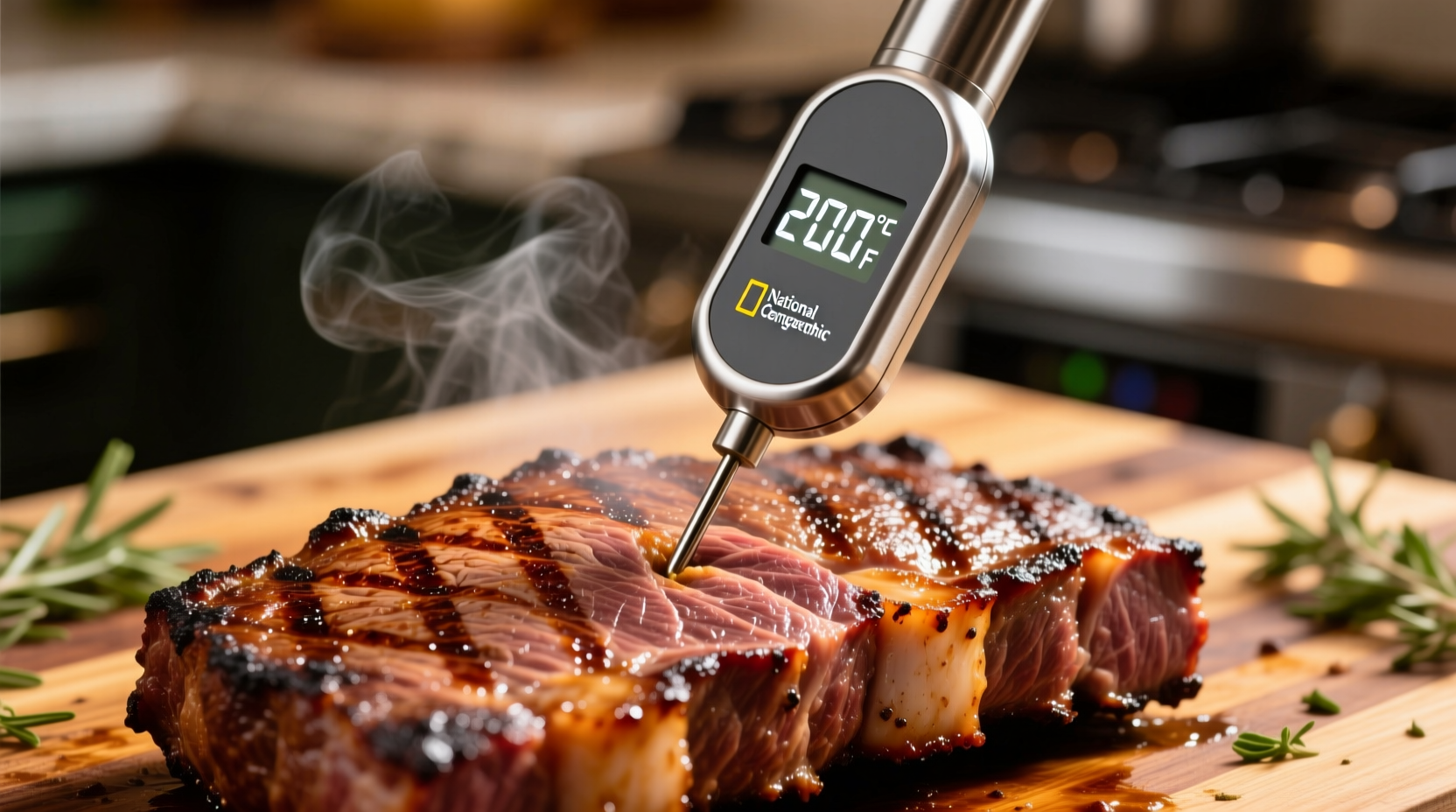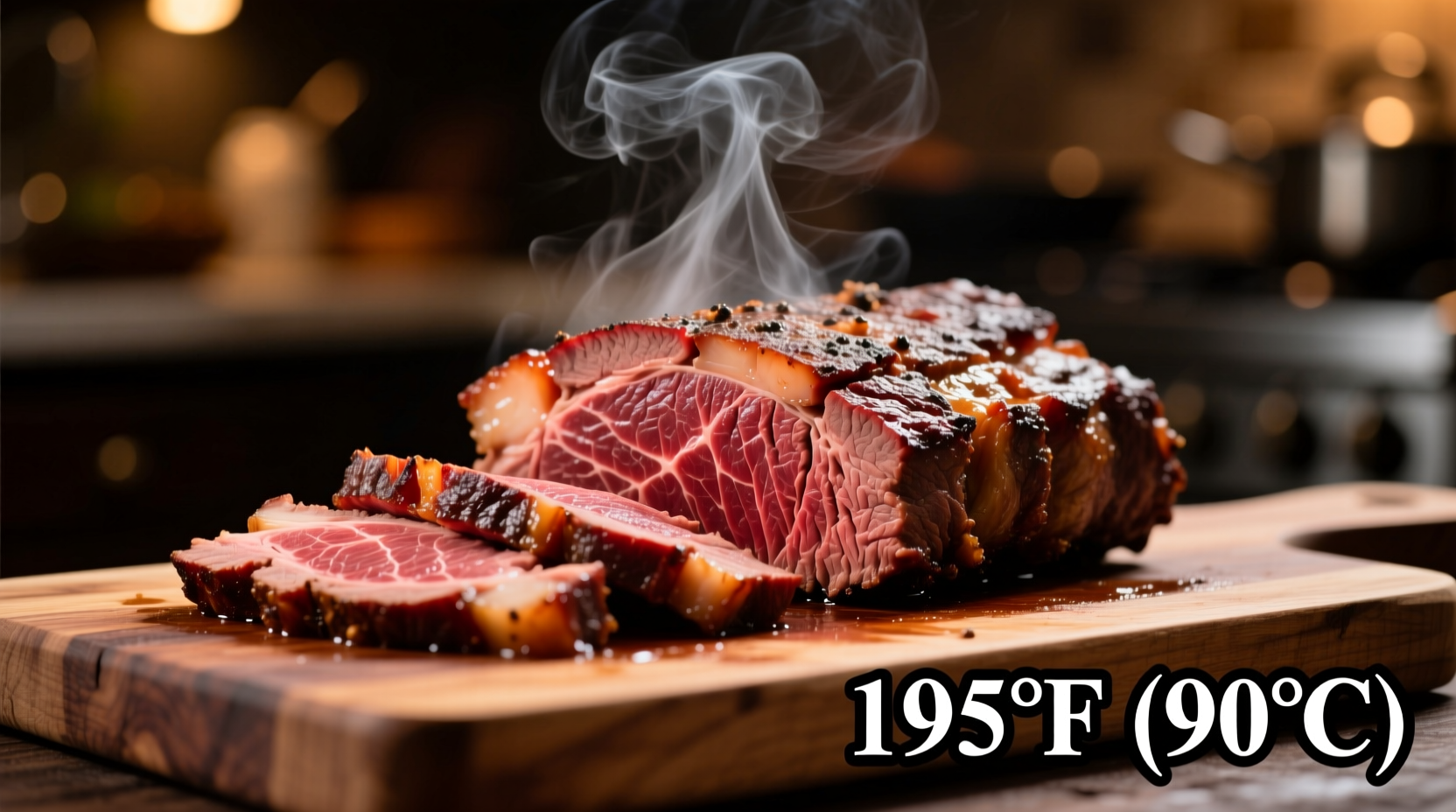The ideal internal temperature for perfectly cooked brisket is 195-205°F (90-96°C). This temperature range ensures complete collagen breakdown and fat rendering, resulting in tender, pull-apart meat. Never rely solely on cooking time—always use a reliable meat thermometer for accuracy.
Why Temperature Matters More Than Time for Brisket
Unlike most cuts of meat where time alone can yield decent results, brisket's transformation from tough to tender depends entirely on reaching specific internal temperatures. Brisket contains abundant connective tissue that requires precise heat exposure to break down properly.
| Temperature Range | Physical Transformation | Texture Result |
|---|---|---|
| 140-160°F (60-71°C) | Initial protein denaturation | Tough, chewy texture |
| 160-175°F (71-79°C) | Collagen begins breaking down | Firm but sliceable |
| 180-195°F (82-91°C) | Significant collagen conversion to gelatin | Tender with clean slices |
| 195-205°F (90-96°C) | Complete collagen breakdown and fat rendering | Melt-in-your-mouth tenderness |
The Science Behind Brisket's Temperature Journey
Brisket's transformation relies on collagen conversion—a process that begins around 160°F and continues through 205°F. According to meat science research from Texas A&M University's Department of Animal Science, collagen requires sustained heat exposure to convert to gelatin, which gives properly cooked brisket its signature texture.
During cooking, you'll encounter the stall—a plateau where evaporation cools the meat, typically between 150-170°F. This isn't a problem but a natural part of the process. Resist the urge to increase heat dramatically; patience yields better results.

Temperature Measurement Best Practices
Accurate temperature reading separates successful brisket from disappointment. Follow these professional techniques:
- Use a dual-probe thermometer with instant-read capability for spot checks
- Target the thickest part of the flat section, avoiding fat pockets
- Check multiple locations as temperature can vary across the brisket
- Insert probe parallel to the board to measure center temperature accurately
- Allow 10-15 seconds for reading stabilization before recording
American Association of Meat Scientists confirms that temperature variance within brisket can reach 20°F, making multiple readings essential for accuracy.
Cooking Method Variations and Temperature Targets
While the target internal temperature remains consistent, your cooking method affects how you reach it:
Smoking (Traditional Method)
Maintain smoker at 225-250°F. Plan for 1-1.5 hours per pound. When brisket hits 165°F, many pitmasters wrap in butcher paper or foil (the "Texas crutch") to push through the stall. Continue cooking until reaching 195-205°F.
Oven Cooking
Set oven to 275°F with a water pan for moisture. Follow similar timing but expect slightly faster cooking. Unwrap during final temperature climb for better bark formation.
Sous Vide Precision
Vacuum-seal brisket and cook at 165°F for 24-36 hours, then finish with high-heat sear. This method bypasses the stall entirely but requires longer cooking time.
Visual and Textural Indicators Beyond Temperature
While thermometer readings are crucial, professional pitmasters use additional indicators:
- The probe test: A thermometer or skewer should slide in with almost no resistance
- Bend test: When lifted with tongs, properly cooked brisket should bend significantly
- Surface appearance: Deep mahogany color with slight jiggle when shaken
- Steam release: Minimal steam when probing indicates complete rendering
Food Safety and Inspection Service data shows that while USDA minimum safe temperature for beef is 145°F, this is insufficient for brisket tenderness. The extended cooking time at higher temperatures ensures safety through time-temperature relationships.
Troubleshooting Common Temperature Issues
Brisket Stuck in the Stall
If your brisket remains between 150-170°F for hours:
- Consider wrapping to accelerate through the stall
- Ensure consistent smoker temperature (fluctuations prolong stall)
- Be patient—natural unwrapped stall can last 6+ hours
Temperature Overshoot (210°F+)
If you accidentally exceed 205°F:
- Immediately remove from heat
- Slice and toss with cooking juices to restore moisture
- Use for burnt ends or chopped barbecue rather than slices
Uneven Temperature Distribution
When parts read significantly different temperatures:
- Rotate brisket in cooker for even exposure
- Place thicker sections toward heat source
- Consider separating point from flat for individual cooking
Resting: The Critical Final Step
After reaching target temperature, rest brisket for 1-2 hours wrapped in a cooler or warm oven. This allows:
- Temperature equalization throughout the meat
- Residual heat to complete rendering process
- Juices to redistribute for maximum moisture retention
- Carryover cooking to add 5-15°F naturally
National Center for Biotechnology Information research confirms that proper resting significantly improves meat texture and juiciness through continued enzymatic activity.
FAQ: Brisket Temperature Questions Answered
Here are answers to the most common questions about brisket cooking temperatures:











 浙公网安备
33010002000092号
浙公网安备
33010002000092号 浙B2-20120091-4
浙B2-20120091-4